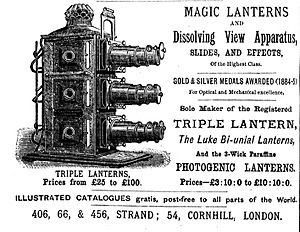Dissolving views facts for kids
Dissolving views were a cool kind of show popular in the 1800s. They used a magic lantern to slowly change one projected picture into another. Imagine a scene of a sunny day slowly turning into a starry night, or a green summer landscape becoming a snowy winter one! This effect is a lot like the "dissolve" you see in movies today.
To make this happen, two matching pictures were lined up. One picture would slowly fade away while the second picture slowly appeared. This made it look like the scene was magically changing. Dissolving views were similar to "diorama" theatre paintings, which were popular in Paris starting in 1822. Sometimes, people even used the words "dissolving views" and "diorama" to mean the same thing.
While many dissolving views showed landscapes changing, they also showed other things. For example, one show made a forest change into a cathedral! Another popular show featured a soldier dreaming on a battlefield, with his dreams about home appearing above his head.
Who Invented Dissolving Views?
The idea for the dissolve effect might have come from Paul de Philipsthal in 1804. He was famous for his "phantasmagoria" shows, which used lanterns to project spooky images. He wanted to make a ghost appear from a mist. While working on this, he realized the same trick could be used for landscapes.
It's not clear if De Philipsthal used this effect much after 1804. But in 1812, a newspaper mentioned his show included "landscapes... which insensibly change to various scenes producing a very magical effect." Later, in 1827, he returned with a show that featured "various splendid views... transforming themselves imperceptibly."
Another person who might have invented dissolving views was Henry Langdon Childe. Some say he came up with the idea in 1807 and made it even better by 1818. However, there are no records of him performing with a magic lantern before 1827. That year, he showed "Scenic Views, showing the various effects of light and shade." These shows featured scenes that became very popular in dissolving view performances.
In 1826, a Scottish magician named M. Henry introduced his own "Beautiful Dissolvent Scenes." He called them "imperceptibly changing views" or "Magic Views," and said they were made with his own special machines.
The first time the exact words "dissolving views" were used was on posters for Childe's shows in London in 1837. Childe then made dissolving views even more famous at the Royal Polytechnic Institution in the early 1840s.
How Dissolving Views Worked
To make dissolving views easier, special "biunial lanterns" were created. These lanterns had two projectors in one machine. The first biunial lantern was probably called the "Biscenascope" and was shown in London in 1840. Later, "triple lanterns" were made, which allowed for even more cool effects, like snow falling while a green scene changed into a winter one.
The magic lantern could have a special mechanical part. This part would slowly close a shutter on the first picture slide while at the same time opening a shutter on the second picture slide. This created the smooth fading effect.
At first, all the slides for dissolving views were painted by hand. Later, a printing process developed in 1823 might have made it easier to create duplicate slides. These printed outlines could then be colored differently to make the changing scenes.
See also
 In Spanish: Disolución de imágenes para niños
In Spanish: Disolución de imágenes para niños


